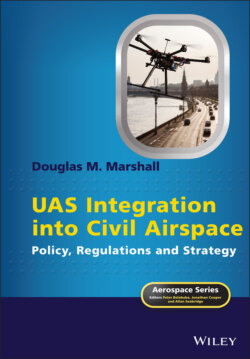Читать книгу UAS Integration into Civil Airspace - Douglas M. Marshall - Страница 13
A Brief History of Aviation Regulations
ОглавлениеAlthough the first powered flight with a pilot on board is attributed to the Wright Brothers (specifically with Orville, the daring one, at the controls) at 10:35 a.m. on 17 December 1903 near Kitty Hawk, North Carolina, the first aviation regulations did not appear for another eight years when Great Britain passed the Aerial Navigation Act of 1911. The British followed that law with a second Aerial Navigation Act of 1913, which transferred the control of aviation activities to the Secretary of State for War. In 1916 the British Air Board was created, which greatly influenced the post-World War I control of civil aviation in Great Britain (Chaplin 2011).
Although the United States did not initiate the first efforts to create aviation safety regulations, the US system of regulations, whether aviation related or not, bears closer examination because the US is historically viewed as a leader in the evolution of aviation regulations world-wide. Regulations, and the supporting standards and guidance materials that help people and organizations comply with them, have been a core component of the legal system in the United States for nearly 150 years. Every federal regulatory agency promulgates rules that are intended to carry out the agency’s legislative mandates. State and local regulatory agencies or commissions act in much the same way.
Lawmakers in most countries generally do not have the luxury of time, expertise, or the resources to define and monitor every element of the particular industry or activity that they undertake to regulate through the enactment of laws that are national in scope. The agencies that the US Congress creates and funds, for example, are delegated the legislative powers that Congress has been granted by Article, Section 1 of the US Constitution. Those delegated powers are implemented through the rule-making process. The oldest federal regulatory agency that still exists in the US is the Office of the Comptroller of the Currency, which was created in 1863 to charter and regulate the nation’s banks. The modern era of federal regulation really began with the creation of the Interstate Commerce Commission (ICC) in 1887, which was directed to protect the public from excessive and discriminatory railroad rates. The regulation was economic in nature, by the setting of rates and by regulating how railroad services were to be provided. The ICC’s administrative model was that of an independent, bipartisan commission that used an adjudicatory approach to arrive at decisions on contested matters. This structure was adopted by several subsequently created agencies, such as the Federal Trade Commission (FTC), the Water Power Commission (later the Federal Power Commission), and the Federal Radio Commission (which became the Federal Communications Commission). Congress created several other agencies early in the 20th century to regulate commercial and financial systems – including the Federal Reserve Board, the Tariff Commission, the Packers and Stockyards Administration, and the Commodities Exchange Authority, all established before 1922. The Food and Drug Administration was created in 1931 to ensure that certain foods and drugs were fit for human consumption.
Many other federal regulatory agencies were created in the 1930s as part of President Franklyn D. Roosevelt’s “New Deal” programs. These included the Federal Home Loan Bank Board (1932), the Federal Deposit Insurance Corporation (FDIC) (1933), the Commodity Credit Corporation (1933), the Farm Credit Administration (1933), the Securities and Exchange Commission (SEC) (1934), and the National Labor Relations Board (1935). The jurisdictions of both the Federal Communications Commission (FCC) and the Interstate Commerce Commission were also expanded to regulate other methods of communications (e.g. telephone and telegraph) as well as other transportation modes (trucking, pipelines, and common carriers such as bus lines and telephones). The ICC was dissolved in 1995, and its remaining powers were reassigned to the Surface Transportation Board.
The United States’ first attempt to regulate commercial aviation arose out of the US Post Office’s commencement of airmail operations in 1918. The first published aviation regulations were released in 1926 by the Aeronautics Branch of the Department of Commerce, and were known as “Air Commerce Regulations.” They consisted of six chapters spanning 45 pages of text, and covered the areas of Licensing, Marking, and Operation of Aircraft, Licensing of Pilots and Mechanics, Air Traffic Rules, and were rounded out by a miscellaneous section. Aviation is indeed one of the oldest regulated industries or activities in the US. Presently the Federal Aviation Regulations (FARs) fill four volumes of the Code of Federal Regulations, consisting of over 460 sections filling more than 3600 pages, and totaling around 8400 regulations, counting major subparts and sections.
